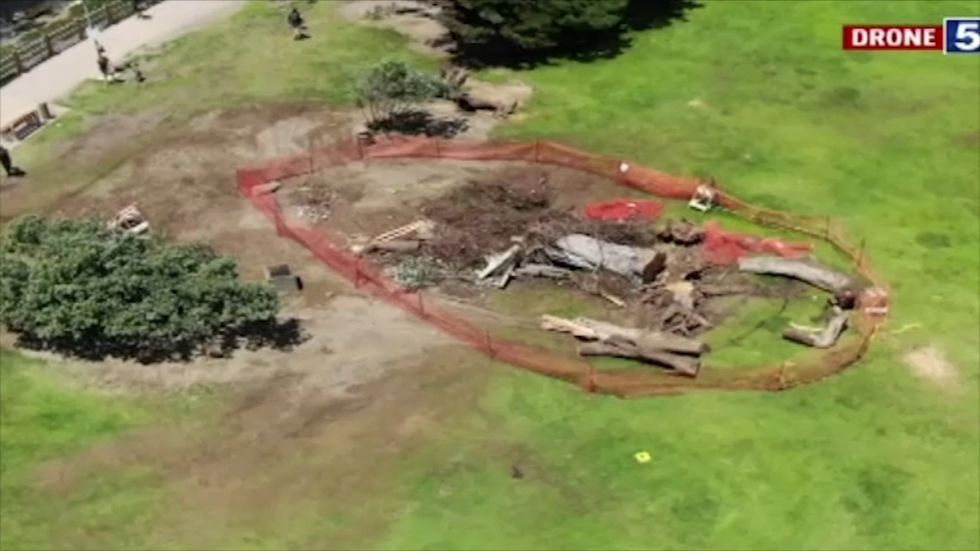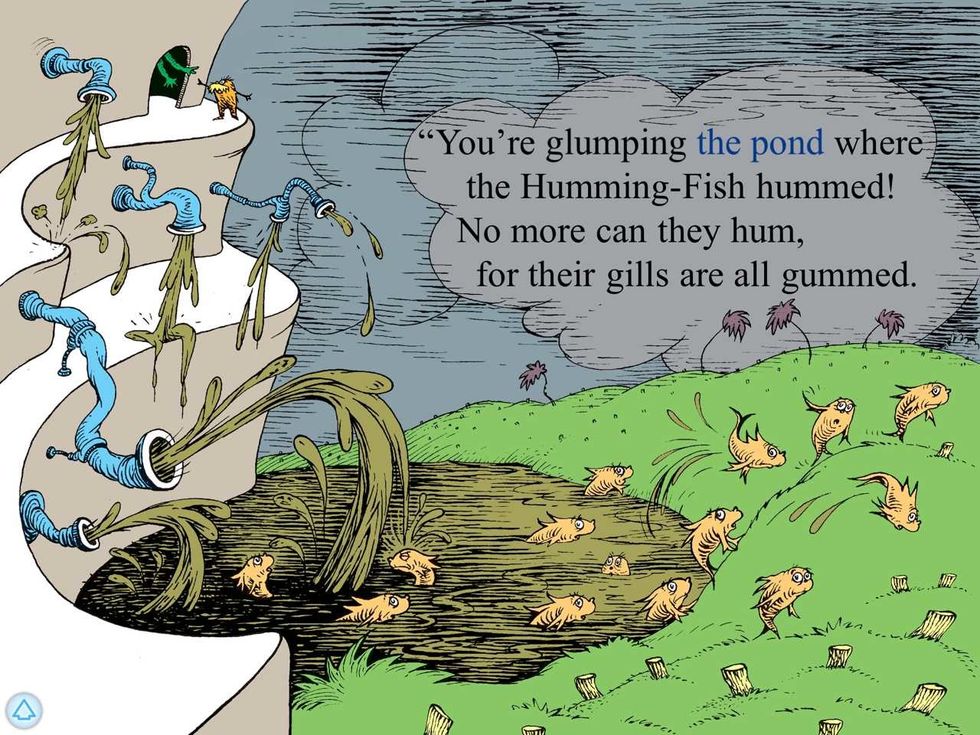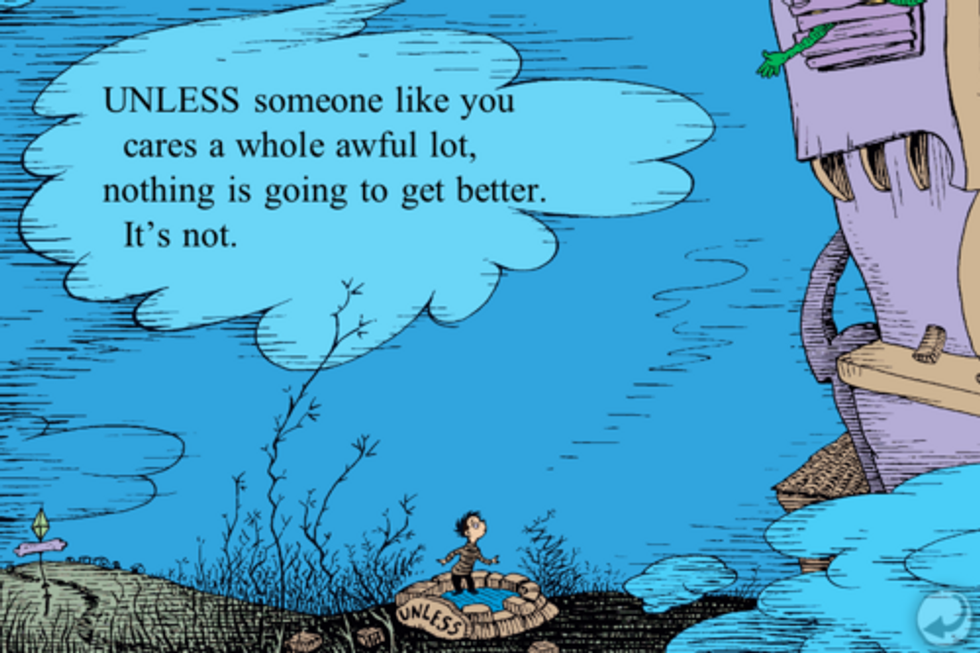If you’ve somehow managed to successfully compartmentalize and ignore the fact that the earth is literally dying, perhaps this will jolt you out of your slumber: The tree that is believed to have inspired Dr. Seuss’s iconic conservation-themed short story, “The Lorax,” has fallen.
 Image via ABC13
Image via ABC13
The tree in question was a Monterey Cypress, which grew without incident for 80 to 100 years in a La Jolla, California park until it suddenly keeled over on June 16. Dr. Seuss, whose real name was Theodor Seuss Geisel, could see the tree from the La Jolla apartment where he lived from 1948 until his death in 1991. It is believed that the cypress, with its curved trunk and abundant leaves, inspired the Truffala Trees that the Lorax in the story dedicates himself to defending—until a greedy factory owner cuts them all down, poisons the rivers, and fills the sky with smog. At the end of the story, the Lorax hangs his head and floats off into a tiny gap in the clouds, lamenting the death of his beloved forest and the creatures that called it home.
The Lorax- trailerwww.youtube.com
In 1971, the year “The Lorax” was published, scientists were just beginning to sound the alarm about climate change. That year, a coalition of leading scientists reported significant risks from global climate change caused by human activity; by the end of the decade, scientific consensus identified global warming as the largest risk of the 21st century. Still, largely due to misleading reports from companies like Exxon, right-wing denialist think tanks, multi-million dollar denial campaigns, and bribes given to politicians by oil barons and investors such as the Koch Brothers, climate change was delegitimized, relegated to the back burner of public and political consciousness.
Flash forward to 2019, and the consequences of that corruption and ignorance are coming back to bite all of us. Wildfires, hurricanes, tsunamis, and droughts—each of which has catalyzed waves of refugees and deepened wounds of already existent economic disparity—are just a few of the visible consequences of climate change; and the worst is yet to come. Roughly 80,000 acres of forest disappear each day, with another 80,000 experiencing significant degradation. Plusm 1 million species are teetering on the brink of extinction.
If the loss of forests and biodiversity is not enough to chill you to the bone, the effects on humanity have been severe and will become unimaginably extreme if we continue at our current pace of unchecked destruction. Climate change threatens coastal cities with flooding, displaces millions, exacerbates health problems like infectious diseases, triggers asthma attacks, and destroys infrastructure and agriculture. It can cause mental illness and it disadvantages the most vulnerable, threatening communities and nations who lack the resources needed to bounce back from ecological disasters.
And even if you don’t give a shit about poor people, you’re still not safe—for climate change will pose significant risks to financial markets, with food costs, insurance markets, and the mortgage industry all at risk. (For proof, just look at the millions of dollars in liability costs and subsequent bankruptcy faced by Pacific Gas and Electric after the 2018 California wildfires).
So in the shadow of all this horrifying information, it doesn’t seem so far-fetched that the tree that inspired one of the greatest tales of environmental destruction has fallen. Sure, maybe there was something wrong with its roots, or maybe the excess of poison or smoke from the fires or the gas leaks or the plastic particles in the salt-choked rivers did it in. Or maybe the tree just gave up, realizing that the earth was no longer a place for growing things. Its death feels like the real-world embodiment of the Lorax floating away into the murky skies, looking sadly down on the scorched earth that used to hold thousands of trees.
 Image via techwithkids.com
Image via techwithkids.com
Of course, the Seussian tale doesn’t end with the Lorax’s departure. It begins when the kid in the story gets the Once-ler to tell him what happened to the Lorax, and it ends when the Once-ler drops him a tiny Truffala tree seed. “UNLESS someone like you cares a whole lot, nothing is going to get better. It’s not,” says the old storyteller, imploring the kid (and by proxy, all readers) to try and do something, even if it starts with one seed.
In a world where Greta Thunberg—a sixteen-year-old playing hooky—is the most powerful voice in ecological activism, Dr. Seuss’s message doesn’t seem too starry-eyed. Small, improbable leaps of faith might be insignificant in themselves, but they can start waves of action that could be our best chance at launching the worldwide action needed to build a viable (and potentially more equitable) society.
 image via weheartit
image via weheartit
- The Climate Crisis Is About Social Oppression – Liberty Project ›
- Why We’re Trying to Have Kids While the World Falls Apart – Liberty Project ›
- The Lorax Quotes by Dr. Seuss ›
- The secret weapon in fight against climate change | MSNBC ›
- Tree said to have inspired ‘The Lorax’ has fallen down | 11alive.com ›
- Tree said to have inspired ‘The Lorax’ has fallen down – YouTube ›
- Tree that inspired Dr. Seuss’ ‘The Lorax’ falls in California – New … ›
- The tree that inspired Dr. Seuss’s The Lorax has fallen / Boing Boing ›
- Tree thought to have inspired Dr. Seuss’ ‘The Lorax’ has fallen … ›
- Tree that inspired Dr. Seuss’ The Lorax has fallen – CNET ›
- ‘Lorax’ tree thought to have inspired Dr. Seuss has fallen – masslive … ›
- Tree thought to have inspired Dr. Seuss’ ‘The Lorax’ has fallen – CNN ›





